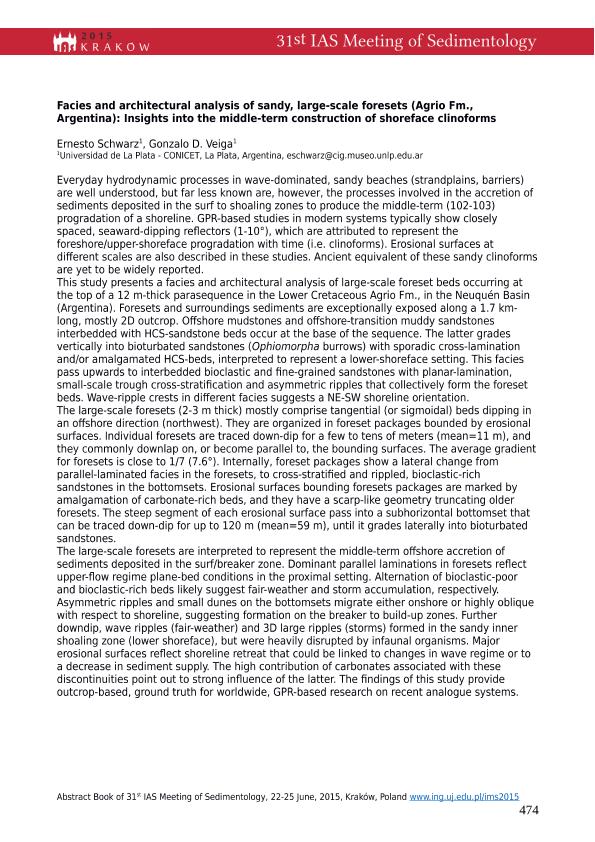Evento
Facies and architectural analysis of sandy, large-scale foresets (Agrio Fm., Argentina): insights into the middle-term construction of shoreface clinoforms
Tipo del evento:
Reunión
Nombre del evento:
31st IAS Meeting of Sedimentology
Fecha del evento:
22/06/2015
Institución Organizadora:
International Association of Sedimentologists;
Título del Libro:
Abstract Book. 31st IAS Meeting of Sedimentology
Editorial:
Polish Geological Society
Idioma:
Inglés
Clasificación temática:
Resumen
Everyday hydrodynamic processes in wave-dominated, sandy beaches (strandplains, barriers) are well understood, but far less known are, however, the processes involved in the accretion of sediments deposited in the surf to shoaling zones to produce the middle-term (102-103) progradation of a shoreline. GPR-based studies in modern systems typically show closely spaced, seaward-dipping reflectors (1-10°), which are attributed to represent the foreshore/upper-shoreface progradation with time (i.e. clinoforms). Erosional surfaces at different scales are also described in these studies. Ancient equivalents of these sand-rich, shoreface clinoforms are yet to be widely reported.This study presents a facies and architectural analysis of large-scale foreset beds occurring at the top of a 12 m-thick parasequence in the Lower Cretaceous Agrio Fm., in the Neuquén Basin (Argentina). Foresets and surroundings sediments are exceptionally exposed along a 1.7 km-long, mostly 2D outcrop. Offshore mudstones and offshore-transition muddy sandstones interbedded with HCS-sandstone beds occur at the base of the sequence. The latter grades vertically into bioturbated sandstones (Ophiomorpha burrows) with sporadic cross-lamination and/or amalgamated HCS-beds, interpreted to represent a lower-shoreface setting. This facies pass upwards to interbedded bioclastic and fine-grained sandstones with planar-lamination, small-scale trough cross-stratification and asymmetric ripples that collectively form the foreset beds. Wave-ripple crests in different facies suggests a NE-SW shoreline orientation. The large-scale foresets (2-3 m thick) mostly comprise tangential (or sigmoidal) beds dipping in an offshore direction (northwest). They are organized in foreset packages bounded by erosional surfaces. Individual foresets are traced down-dip for a few to tens of meters (mean=11 m), and they commonly downlap on, or become parallel to, the bounding surfaces. The average gradient for foresets is close to 1/7 (7.6°). Internally, foreset packages show a lateral change from parallel-laminated facies in the foresets, to cross-stratified and rippled, bioclastic-rich sandstones in the bottomsets. Erosional surfaces bounding foresets packages are marked by amalgamation of carbonate-rich beds, and they have a scarp-like geometry truncating older foresets. The steep segment of each erosional surface pass into a subhorizontal bottomset that can be traced down-dip for up to 120 m (mean=59 m), until it grades laterally into bioturbated sandstones.The large-scale foresets are interpreted to represent the middle-term offshore accretion of sediments deposited in the surf/breaker zone. Dominant parallel laminations in foresets reflect upper-flow regime plane-bed conditions in the proximal setting. Alternation of bioclastic-poor and bioclastic-rich beds likely suggest fair-weather and storm accumulation, respectively. Asymmetric ripples and small dunes on the bottomsets migrate either onshore or highly oblique with respect to shoreline, suggesting formation on the breaker to build-up zones. Further downdip, wave ripples (fair-weather) and 3D large ripples (storms) formed in the sandy inner shoaling zone (lower shoreface), but were heavily disrupted by infaunal organisms. Major erosional surfaces reflect shoreline retreat that could be linked to changes in wave regime or to a decrease in sediment supply. The high contribution of carbonates associated with these discontinuities point out to strong influence of the latter. The findings of this study provide outcrop-based, ground truth for worldwide, GPR-based research on recent analogue systems.
Palabras clave:
COASTAL DEPOSITIONAL SYSTEM
,
PILMATUE MB
,
SHOREFACE CLINOFORMS
Archivos asociados
Licencia
Identificadores
Colecciones
Eventos(CIG)
Eventos de CENTRO DE INVEST.GEOLOGICAS (I)
Eventos de CENTRO DE INVEST.GEOLOGICAS (I)
Citación
Facies and architectural analysis of sandy, large-scale foresets (Agrio Fm., Argentina): insights into the middle-term construction of shoreface clinoforms; 31st IAS Meeting of Sedimentology; Cracovia; Polonia; 2015; 474-474
Compartir




